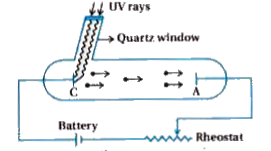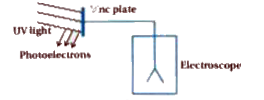Describe Hallwach's and Lenard's observation regarding photoelectric effect in short.Solution in Gujrati
During 1886 and 1902,Hallwach and Lenard studied phenimenon of photoelectric emission .
Lenard.s experiment:

As shown in figure ,two metal electrodes are kept at opposite ends inside evacuated glass tube.
One electrode is called cathode (emitter) which is photo sensitive surface second electrode is called collector A.Potential difference is applied between C and A.
quartz window is provided in this tube through which ultraviolet rays are incident on cathode C.
When ultraviolet rays are incident on cathode (C) is stopped then current in circuit will become zero.
anode (A) is kept at positve voltage w.r.t. cathode (C ) hence it attracts electrons emitted and there is flow of electron.Hence,current flows in the circuit.
When ultraviolet radiation are stopped,current flowing through the circuit will stop
Lenard studied how photo current changes with collector plate potential with frequecny and intensity of incident light.
Hallwach.s experiment:
Hallwach in 1888,connected electroscope with negatively charged zinc plate as shown in figure

Following were his observations:
(i)When UV light was incident on zinc plate it lost its charge.
(ii)Iniially when UV light was incident on chargeless zinc plate,it became positively charged.
(iii)When initially zinc plate was kept positively charged and UV light was incident,positive charge on the plate increased.
From these observation he concluded when UV light is incident on zinc plate,negatively charged particles are emitted from the plat.
He also concluded that when frequency of incident radiation is less than some minimum frequency ,photoelectrons are not emitted.
Topper's Solved these Questions
- BOOK - KUMAR PRAKASHANCHAPTER - DUAL NATURE OF RADIATION AND MATTEREXERCISE - Section-A Try yourself62videos
DUAL NATURE OF RADIATION AND MATTER
- BOOK - KUMAR PRAKASHANCHAPTER - DUAL NATURE OF RADIATION AND MATTEREXERCISE - Section-A Example2videos
DUAL NATURE OF RADIATION AND MATTER
- BOOK - KUMAR PRAKASHANCHAPTER - CURRENT ELECTRICITYEXERCISE - SECTION [D] MULTIPLE CHOICE QUESTIONS (MCQs) (MCQs ASKED IN BOARD EXAM AND GUJCET)23videos
CURRENT ELECTRICITY
- BOOK - KUMAR PRAKASHANCHAPTER - ELECTRIC CHARGES AND FIELDS EXERCISE - SECTION D MCQS ASKED IN COMPETITIVE EXAMES (MCQS AKSED IN BOARD EXAM AND GUJCET)14videos
ELECTRIC CHARGES AND FIELDS
Similar Questions
Who obtained electromagnetic wave first time in the laboratory ?
01:23View SolutionFor electron moving with speed of 20 m/s and accelerated by 120 V p.D. de-Broglie wavelength can be easily obtained.
04:47View SolutionA wire is bent in the form of circle of radius 2m. Resistance per unit length of wire is 1πΩm. Battery of 6 V is connected between A and B ∠AOB=90∘ . Find the current through the battery.
 View Solution
View SolutionWhen air is replaced by dielectric medium of constant K, the maximum force of attraction between two charges separated by distance d, ..........
View SolutionDescribe photoelectric effect and state the laws of photoelectric emission.
03:35View SolutionChoose the correct statements regarding the phenomena of photoelectric effect
06:39View SolutionMark the incorect statement regarding the photoelectric effect.
View SolutionWhich property of photoelectric particles was measured from Lenard's experiment?
08:36View SolutionWhat was Hertz's observation of photoelectric effect.
08:36View SolutionExplain Hallwach's and Lenard's observation on photoelectric effect.
Define :
a.work function
b. Threshold frequency
c. Stopping potential02:09View SolutionDescribe briefly three experimentally observed features in the phenomenon of photoelectric effect.
05:58View SolutionWrite any three experimental observations of photoelectric effect
08:11View SolutionWrite any three experimental observations of photoelectric effect
02:33View SolutionMark the incorect statement regarding the photoelectric effect.
04:37View SolutionWrite the experimental observations of photoelectric effect.
View Solution

